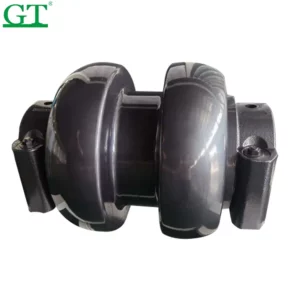The tiltrotator attachment, when installed on an excavator front idler, significantly enhances versatility and efficiency by providing increased flexibility in the manipulation of attachments. Here’s how it achieves this:
- 360-Degree Rotation: The tiltrotator allows for continuous 360-degree rotation of attachments, such as buckets, grapples, or hydraulic breakers, around the longitudinal axis of the excavator arm. This rotation capability enables operators to easily access and work in tight or confined spaces without having to reposition the entire excavator, improving efficiency and reducing the need for manual labor.
- Tilting Functionality: In addition to rotation, the tiltrotator attachment allows for tilting of attachments, typically up to 45 degrees in both directions. This tilting functionality enables operators to adjust the angle of attachments to match the contours of the terrain or to achieve precise positioning for excavation, grading, or material handling tasks. It enhances versatility and accuracy in various applications, such as ditching, slope shaping, or trenching.
- Quick Attachment Changes: Tiltrotators facilitate rapid attachment changes without the need for manual disconnection and reconnection of hydraulic lines. Operators can switch between different attachments seamlessly, improving productivity and reducing downtime on the job site. This feature allows excavators to perform multiple tasks with a single machine, maximizing efficiency and versatility.
- Optimized Working Positions: The tiltrotator attachment enables excavator operators to achieve optimal working positions for various tasks, enhancing visibility, reach, and maneuverability. By adjusting the angle and orientation of attachments, excavator front idler manufacturers operators can access hard-to-reach areas, work around obstacles, and maintain a safe distance from hazardous terrain or structures, improving overall efficiency and safety.
- Reduced Manual Labor: Tiltrotators minimize the need for manual labor and auxiliary equipment, such as additional excavators or backhoes, by enabling excavators to perform a wider range of tasks with greater precision and efficiency. This reduces labor costs, equipment expenses, and the logistical challenges associated with deploying multiple machines for different tasks.
- Enhanced Operator Control: Tiltrotator attachments are typically equipped with intuitive control systems that allow operators to adjust rotation, tilt, and other parameters with ease. Advanced control features, such as proportional control joysticks or touchscreen interfaces, provide operators with precise and responsive control over attachment movements, enhancing productivity and accuracy on the job site.
- Versatility Across Applications: Tiltrotator attachments are highly versatile and can be used in a wide range of applications, including excavation, landscaping, road construction, utilities installation, demolition, and more. Their ability to adapt to different tasks and environments makes them indispensable tools for contractors and operators seeking to maximize the capabilities of their excavators.
Overall, the tiltrotator attachment in excavator front idlers significantly enhances versatility and efficiency by enabling continuous rotation, tilting functionality, quick attachment changes, optimized working positions, reduced manual labor, enhanced operator control, and versatility across various applications. It represents a valuable investment for contractors and operators seeking to improve productivity, safety, and profitability on construction and earthmoving projects.
What are the benefits of using a excavator ldler with a variable boom offset feature?
Using an excavator idler with a variable boom offset feature offers several benefits that enhance versatility, productivity, and efficiency on construction and earthmoving projects. Here are some of the key advantages:
- Increased Flexibility: The variable boom offset feature allows operators to adjust the horizontal position of the boom relative to the excavator’s undercarriage. This flexibility enables the excavator to reach and work in a wider range of positions, angles, and orientations, enhancing its versatility across various job site conditions and tasks.
- Improved Access: By adjusting the boom offset, operators can maneuver the excavator to access difficult-to-reach areas, such as tight spaces, steep slopes, or overhead obstacles. This capability increases accessibility and allows for more efficient excavation, grading, trenching, and material handling in challenging environments.
- Enhanced Reach and Range: The variable boom offset extends the reach and range of the excavator, allowing it to work effectively at greater distances from the machine’s tracks or undercarriage. This extended reach is particularly beneficial for tasks such as long-reach digging, material loading, and stockpiling, where reaching over obstacles or across wide areas is required.
- Optimized Working Positions: Operators can adjust the boom offset to achieve optimal working positions for different tasks and applications. Whether working on slopes, uneven terrain, or confined spaces, the ability to fine-tune the boom position enhances visibility, excavator ldler manufacturers stability, and control, resulting in more precise and efficient operation.
- Reduced Ground Disturbance: By offsetting the boom away from the excavator’s tracks, the variable boom offset feature helps minimize ground disturbance and damage to the surrounding terrain. This is especially important in sensitive environments, such as landscaped areas, wetlands, or archaeological sites, where minimizing impact is essential.
- Improved Safety: The variable boom offset feature enhances safety by allowing operators to maintain a safe distance from hazardous or unstable terrain while still effectively performing excavation and material handling tasks. It reduces the risk of accidents, equipment damage, and operator injuries associated with working in challenging or confined spaces.
- Enhanced Productivity: With the ability to adjust the boom offset on the fly, operators can work more efficiently and effectively, completing tasks in less time and with fewer manual adjustments. This increased productivity translates to cost savings, improved project timelines, and greater overall efficiency on the job site.
- Adaptability to Site Conditions: The variable boom offset feature enables excavators to adapt to changing site conditions and project requirements quickly. Operators can easily adjust the boom position to accommodate obstacles, changes in terrain, or variations in excavation depth, ensuring maximum flexibility and adaptability in dynamic work environments.
Overall, using an excavator idler with a variable boom offset feature offers numerous benefits, including increased flexibility, improved access, enhanced reach and range, optimized working positions, reduced ground disturbance, improved safety, enhanced productivity, and adaptability to site conditions. These advantages make it an invaluable tool for contractors and operators seeking to maximize the capabilities of their excavators and achieve efficient and cost-effective results on construction and earthmoving projects.
